Analyzing Leadership Styles for Organizational Improvement
VerifiedAdded on 2020/04/15
|6
|1170
|100
Essay
AI Summary
The discussion revolves around understanding leadership as a crucial element for organizational improvements. It highlights the importance of identifying suitable leadership styles to enhance business progress within multinational companies. The assessment reveals that the author’s leadership style aligns with laissez-faire, indicating potential weaknesses such as poor decision-making and motivational skills. The essay emphasizes analyzing these results to propose necessary modifications for effective leadership, considering the organization's needs and adapting to environmental changes. It concludes by reinforcing the leader's role in guiding organizational success through strategic decisions and adaptability.
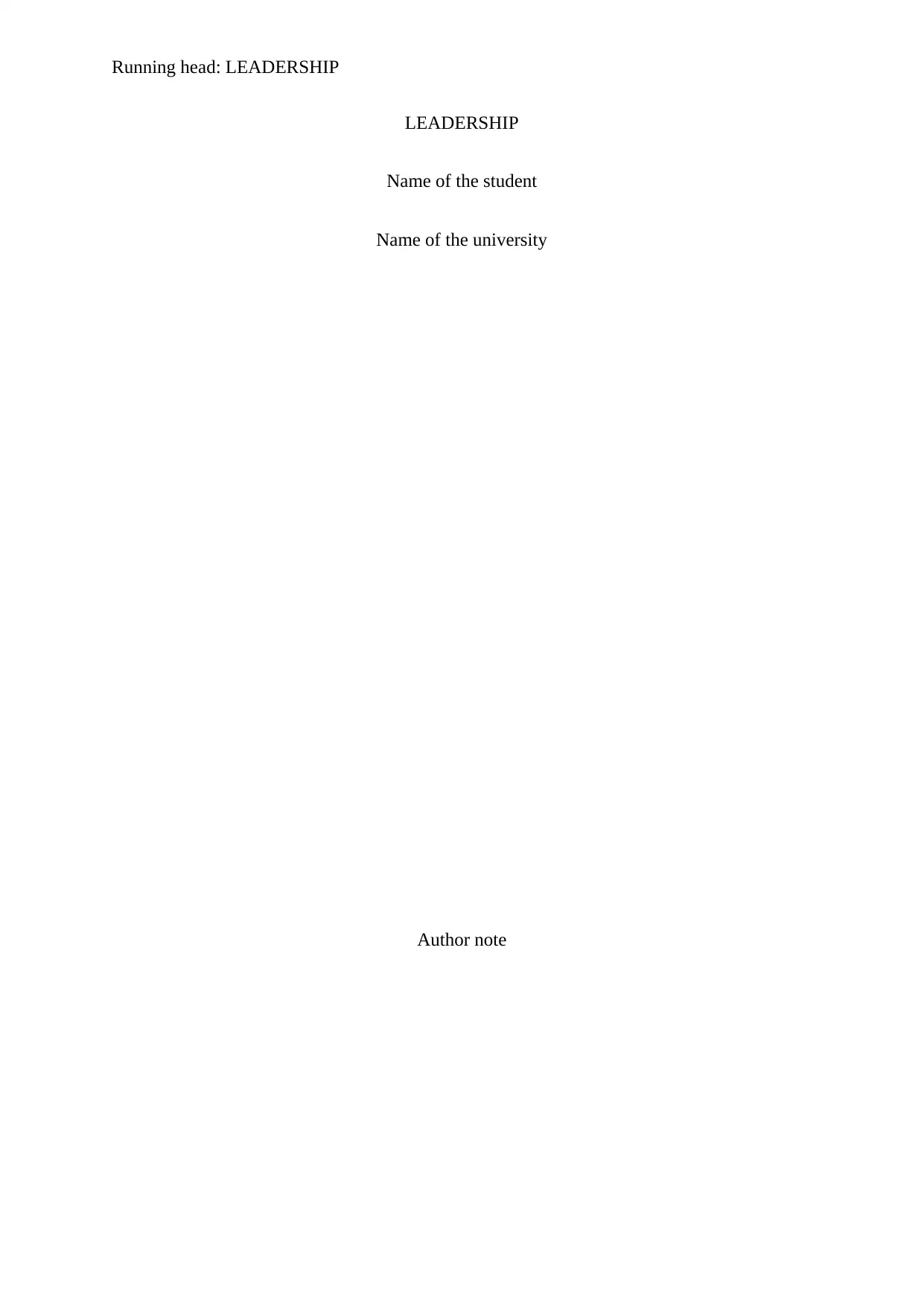
Running head: LEADERSHIP
LEADERSHIP
Name of the student
Name of the university
Author note
LEADERSHIP
Name of the student
Name of the university
Author note
Paraphrase This Document
Need a fresh take? Get an instant paraphrase of this document with our AI Paraphraser
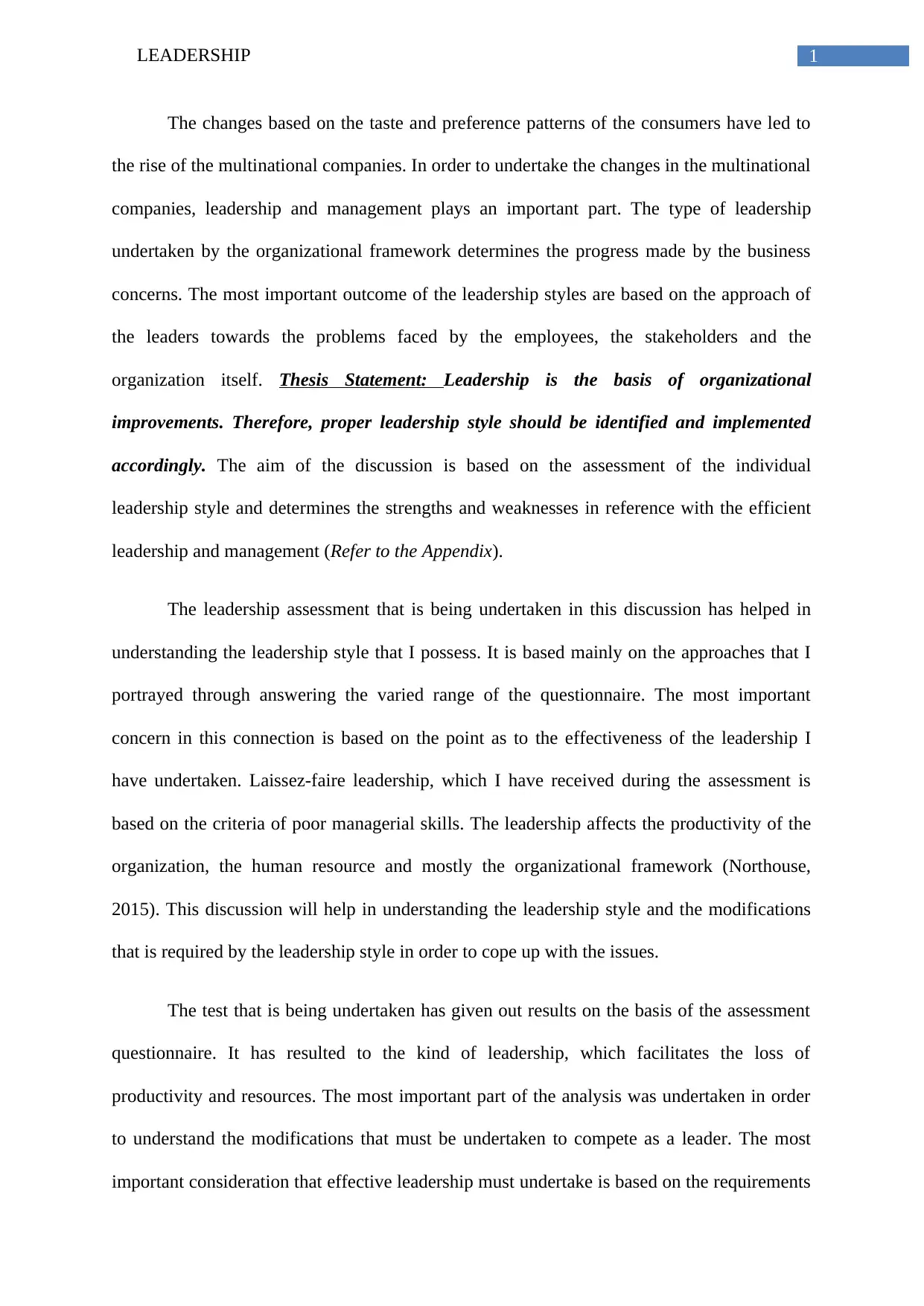
1LEADERSHIP
The changes based on the taste and preference patterns of the consumers have led to
the rise of the multinational companies. In order to undertake the changes in the multinational
companies, leadership and management plays an important part. The type of leadership
undertaken by the organizational framework determines the progress made by the business
concerns. The most important outcome of the leadership styles are based on the approach of
the leaders towards the problems faced by the employees, the stakeholders and the
organization itself. Thesis Statement: Leadership is the basis of organizational
improvements. Therefore, proper leadership style should be identified and implemented
accordingly. The aim of the discussion is based on the assessment of the individual
leadership style and determines the strengths and weaknesses in reference with the efficient
leadership and management (Refer to the Appendix).
The leadership assessment that is being undertaken in this discussion has helped in
understanding the leadership style that I possess. It is based mainly on the approaches that I
portrayed through answering the varied range of the questionnaire. The most important
concern in this connection is based on the point as to the effectiveness of the leadership I
have undertaken. Laissez-faire leadership, which I have received during the assessment is
based on the criteria of poor managerial skills. The leadership affects the productivity of the
organization, the human resource and mostly the organizational framework (Northouse,
2015). This discussion will help in understanding the leadership style and the modifications
that is required by the leadership style in order to cope up with the issues.
The test that is being undertaken has given out results on the basis of the assessment
questionnaire. It has resulted to the kind of leadership, which facilitates the loss of
productivity and resources. The most important part of the analysis was undertaken in order
to understand the modifications that must be undertaken to compete as a leader. The most
important consideration that effective leadership must undertake is based on the requirements
The changes based on the taste and preference patterns of the consumers have led to
the rise of the multinational companies. In order to undertake the changes in the multinational
companies, leadership and management plays an important part. The type of leadership
undertaken by the organizational framework determines the progress made by the business
concerns. The most important outcome of the leadership styles are based on the approach of
the leaders towards the problems faced by the employees, the stakeholders and the
organization itself. Thesis Statement: Leadership is the basis of organizational
improvements. Therefore, proper leadership style should be identified and implemented
accordingly. The aim of the discussion is based on the assessment of the individual
leadership style and determines the strengths and weaknesses in reference with the efficient
leadership and management (Refer to the Appendix).
The leadership assessment that is being undertaken in this discussion has helped in
understanding the leadership style that I possess. It is based mainly on the approaches that I
portrayed through answering the varied range of the questionnaire. The most important
concern in this connection is based on the point as to the effectiveness of the leadership I
have undertaken. Laissez-faire leadership, which I have received during the assessment is
based on the criteria of poor managerial skills. The leadership affects the productivity of the
organization, the human resource and mostly the organizational framework (Northouse,
2015). This discussion will help in understanding the leadership style and the modifications
that is required by the leadership style in order to cope up with the issues.
The test that is being undertaken has given out results on the basis of the assessment
questionnaire. It has resulted to the kind of leadership, which facilitates the loss of
productivity and resources. The most important part of the analysis was undertaken in order
to understand the modifications that must be undertaken to compete as a leader. The most
important consideration that effective leadership must undertake is based on the requirements
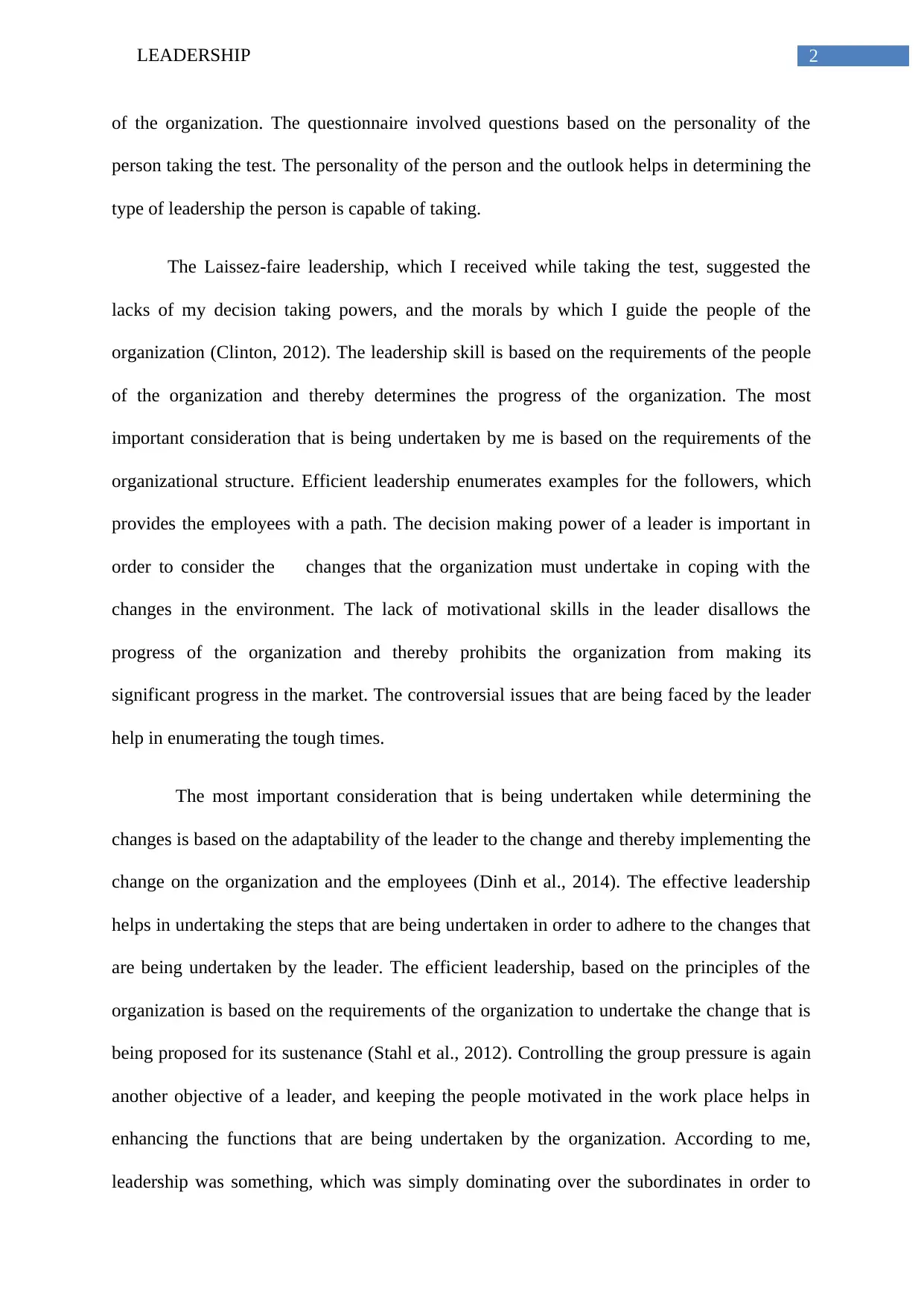
2LEADERSHIP
of the organization. The questionnaire involved questions based on the personality of the
person taking the test. The personality of the person and the outlook helps in determining the
type of leadership the person is capable of taking.
The Laissez-faire leadership, which I received while taking the test, suggested the
lacks of my decision taking powers, and the morals by which I guide the people of the
organization (Clinton, 2012). The leadership skill is based on the requirements of the people
of the organization and thereby determines the progress of the organization. The most
important consideration that is being undertaken by me is based on the requirements of the
organizational structure. Efficient leadership enumerates examples for the followers, which
provides the employees with a path. The decision making power of a leader is important in
order to consider the changes that the organization must undertake in coping with the
changes in the environment. The lack of motivational skills in the leader disallows the
progress of the organization and thereby prohibits the organization from making its
significant progress in the market. The controversial issues that are being faced by the leader
help in enumerating the tough times.
The most important consideration that is being undertaken while determining the
changes is based on the adaptability of the leader to the change and thereby implementing the
change on the organization and the employees (Dinh et al., 2014). The effective leadership
helps in undertaking the steps that are being undertaken in order to adhere to the changes that
are being undertaken by the leader. The efficient leadership, based on the principles of the
organization is based on the requirements of the organization to undertake the change that is
being proposed for its sustenance (Stahl et al., 2012). Controlling the group pressure is again
another objective of a leader, and keeping the people motivated in the work place helps in
enhancing the functions that are being undertaken by the organization. According to me,
leadership was something, which was simply dominating over the subordinates in order to
of the organization. The questionnaire involved questions based on the personality of the
person taking the test. The personality of the person and the outlook helps in determining the
type of leadership the person is capable of taking.
The Laissez-faire leadership, which I received while taking the test, suggested the
lacks of my decision taking powers, and the morals by which I guide the people of the
organization (Clinton, 2012). The leadership skill is based on the requirements of the people
of the organization and thereby determines the progress of the organization. The most
important consideration that is being undertaken by me is based on the requirements of the
organizational structure. Efficient leadership enumerates examples for the followers, which
provides the employees with a path. The decision making power of a leader is important in
order to consider the changes that the organization must undertake in coping with the
changes in the environment. The lack of motivational skills in the leader disallows the
progress of the organization and thereby prohibits the organization from making its
significant progress in the market. The controversial issues that are being faced by the leader
help in enumerating the tough times.
The most important consideration that is being undertaken while determining the
changes is based on the adaptability of the leader to the change and thereby implementing the
change on the organization and the employees (Dinh et al., 2014). The effective leadership
helps in undertaking the steps that are being undertaken in order to adhere to the changes that
are being undertaken by the leader. The efficient leadership, based on the principles of the
organization is based on the requirements of the organization to undertake the change that is
being proposed for its sustenance (Stahl et al., 2012). Controlling the group pressure is again
another objective of a leader, and keeping the people motivated in the work place helps in
enhancing the functions that are being undertaken by the organization. According to me,
leadership was something, which was simply dominating over the subordinates in order to
⊘ This is a preview!⊘
Do you want full access?
Subscribe today to unlock all pages.

Trusted by 1+ million students worldwide
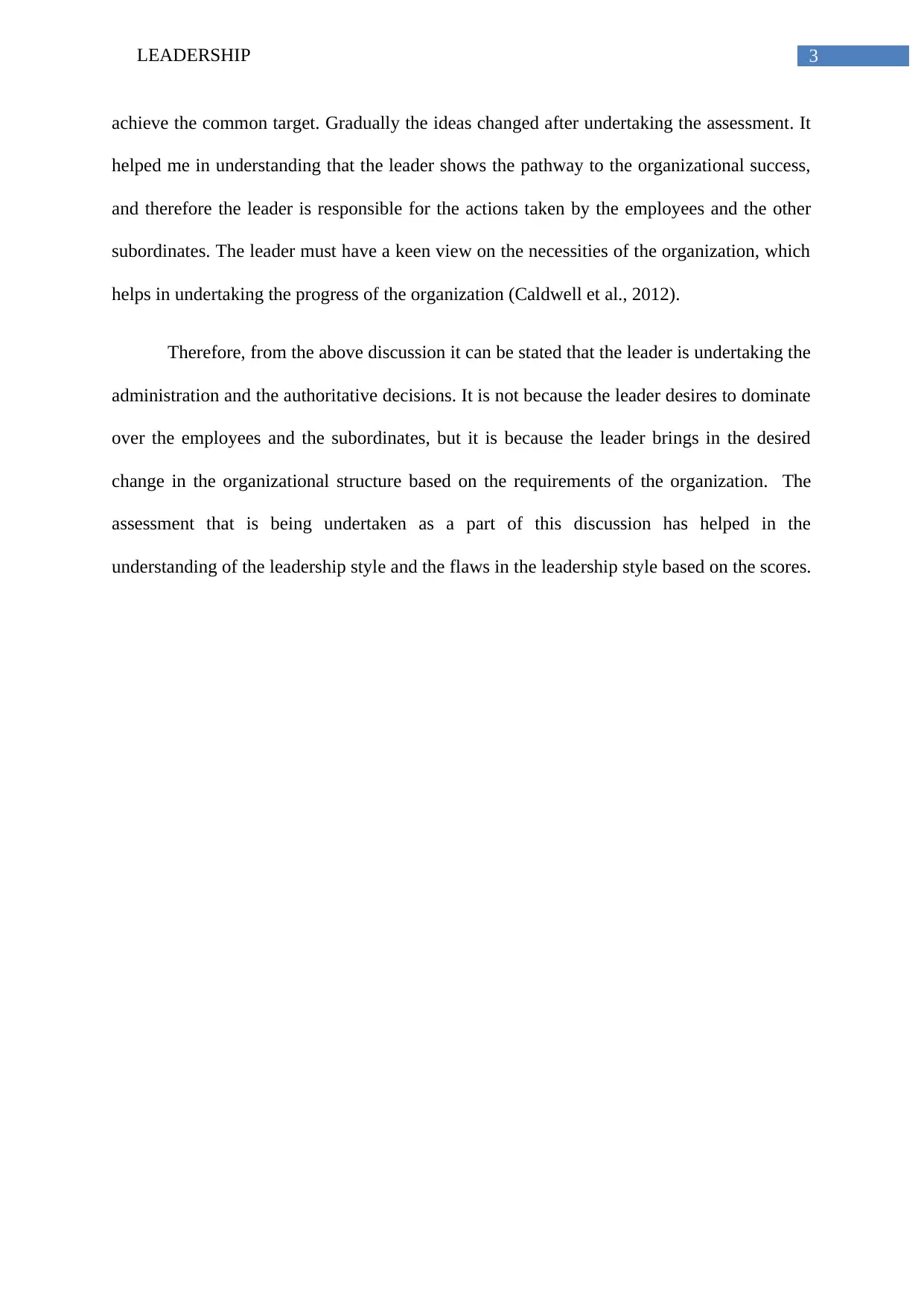
3LEADERSHIP
achieve the common target. Gradually the ideas changed after undertaking the assessment. It
helped me in understanding that the leader shows the pathway to the organizational success,
and therefore the leader is responsible for the actions taken by the employees and the other
subordinates. The leader must have a keen view on the necessities of the organization, which
helps in undertaking the progress of the organization (Caldwell et al., 2012).
Therefore, from the above discussion it can be stated that the leader is undertaking the
administration and the authoritative decisions. It is not because the leader desires to dominate
over the employees and the subordinates, but it is because the leader brings in the desired
change in the organizational structure based on the requirements of the organization. The
assessment that is being undertaken as a part of this discussion has helped in the
understanding of the leadership style and the flaws in the leadership style based on the scores.
achieve the common target. Gradually the ideas changed after undertaking the assessment. It
helped me in understanding that the leader shows the pathway to the organizational success,
and therefore the leader is responsible for the actions taken by the employees and the other
subordinates. The leader must have a keen view on the necessities of the organization, which
helps in undertaking the progress of the organization (Caldwell et al., 2012).
Therefore, from the above discussion it can be stated that the leader is undertaking the
administration and the authoritative decisions. It is not because the leader desires to dominate
over the employees and the subordinates, but it is because the leader brings in the desired
change in the organizational structure based on the requirements of the organization. The
assessment that is being undertaken as a part of this discussion has helped in the
understanding of the leadership style and the flaws in the leadership style based on the scores.
Paraphrase This Document
Need a fresh take? Get an instant paraphrase of this document with our AI Paraphraser
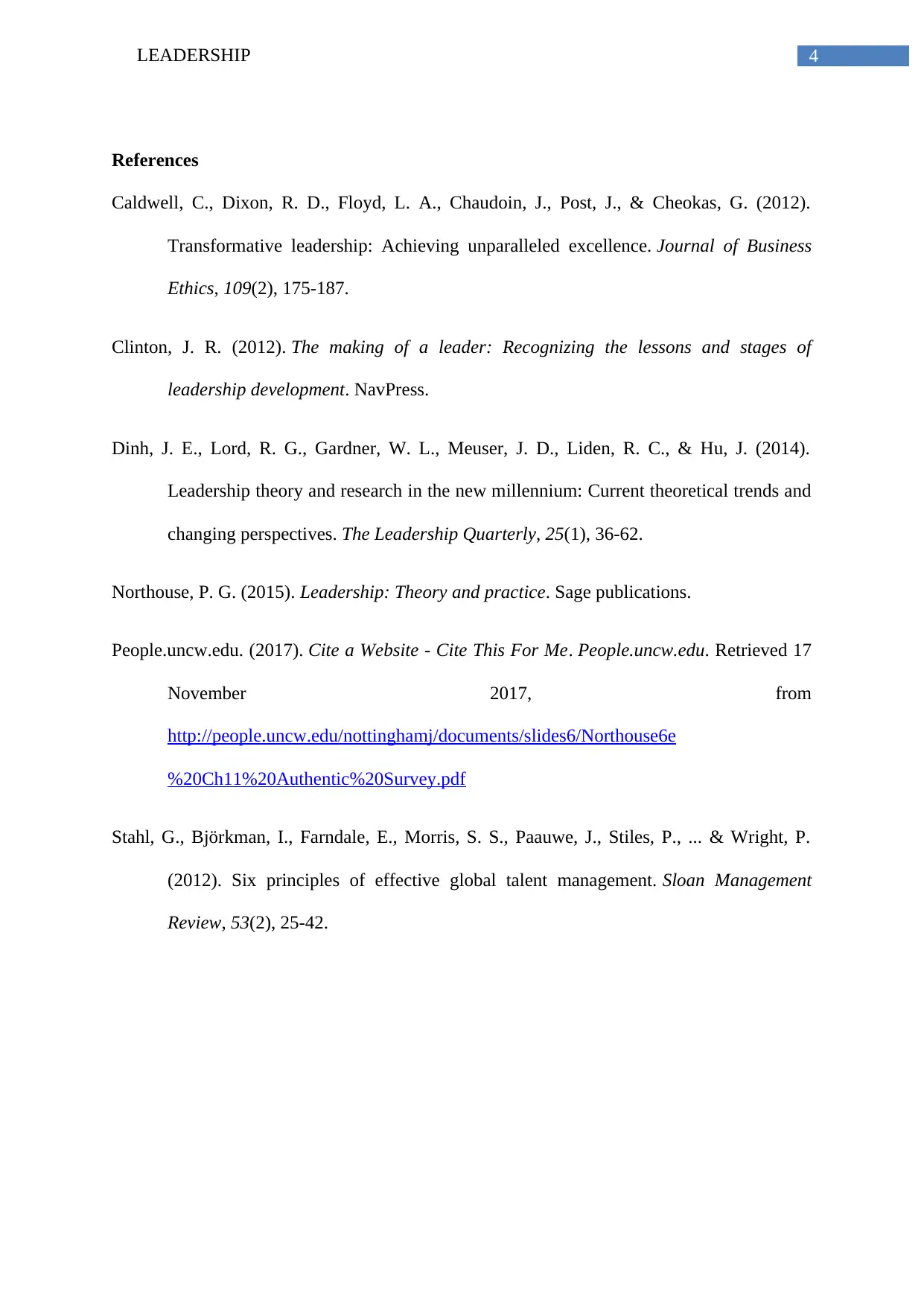
4LEADERSHIP
References
Caldwell, C., Dixon, R. D., Floyd, L. A., Chaudoin, J., Post, J., & Cheokas, G. (2012).
Transformative leadership: Achieving unparalleled excellence. Journal of Business
Ethics, 109(2), 175-187.
Clinton, J. R. (2012). The making of a leader: Recognizing the lessons and stages of
leadership development. NavPress.
Dinh, J. E., Lord, R. G., Gardner, W. L., Meuser, J. D., Liden, R. C., & Hu, J. (2014).
Leadership theory and research in the new millennium: Current theoretical trends and
changing perspectives. The Leadership Quarterly, 25(1), 36-62.
Northouse, P. G. (2015). Leadership: Theory and practice. Sage publications.
People.uncw.edu. (2017). Cite a Website - Cite This For Me. People.uncw.edu. Retrieved 17
November 2017, from
http://people.uncw.edu/nottinghamj/documents/slides6/Northouse6e
%20Ch11%20Authentic%20Survey.pdf
Stahl, G., Björkman, I., Farndale, E., Morris, S. S., Paauwe, J., Stiles, P., ... & Wright, P.
(2012). Six principles of effective global talent management. Sloan Management
Review, 53(2), 25-42.
References
Caldwell, C., Dixon, R. D., Floyd, L. A., Chaudoin, J., Post, J., & Cheokas, G. (2012).
Transformative leadership: Achieving unparalleled excellence. Journal of Business
Ethics, 109(2), 175-187.
Clinton, J. R. (2012). The making of a leader: Recognizing the lessons and stages of
leadership development. NavPress.
Dinh, J. E., Lord, R. G., Gardner, W. L., Meuser, J. D., Liden, R. C., & Hu, J. (2014).
Leadership theory and research in the new millennium: Current theoretical trends and
changing perspectives. The Leadership Quarterly, 25(1), 36-62.
Northouse, P. G. (2015). Leadership: Theory and practice. Sage publications.
People.uncw.edu. (2017). Cite a Website - Cite This For Me. People.uncw.edu. Retrieved 17
November 2017, from
http://people.uncw.edu/nottinghamj/documents/slides6/Northouse6e
%20Ch11%20Authentic%20Survey.pdf
Stahl, G., Björkman, I., Farndale, E., Morris, S. S., Paauwe, J., Stiles, P., ... & Wright, P.
(2012). Six principles of effective global talent management. Sloan Management
Review, 53(2), 25-42.
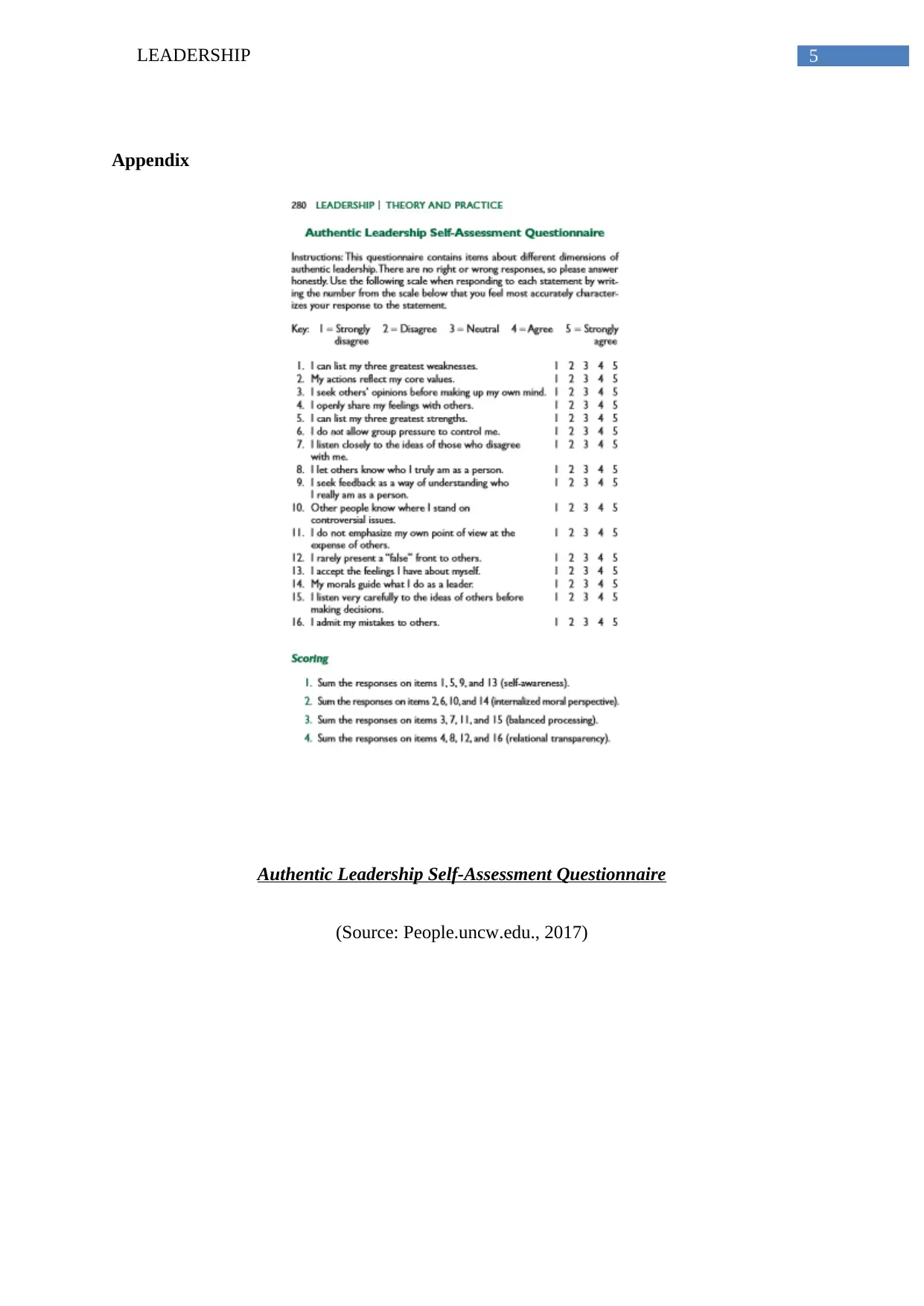
5LEADERSHIP
Appendix
Authentic Leadership Self-Assessment Questionnaire
(Source: People.uncw.edu., 2017)
Appendix
Authentic Leadership Self-Assessment Questionnaire
(Source: People.uncw.edu., 2017)
⊘ This is a preview!⊘
Do you want full access?
Subscribe today to unlock all pages.

Trusted by 1+ million students worldwide
1 out of 6
Related Documents
Your All-in-One AI-Powered Toolkit for Academic Success.
+13062052269
info@desklib.com
Available 24*7 on WhatsApp / Email
![[object Object]](/_next/static/media/star-bottom.7253800d.svg)
Unlock your academic potential
Copyright © 2020–2025 A2Z Services. All Rights Reserved. Developed and managed by ZUCOL.





